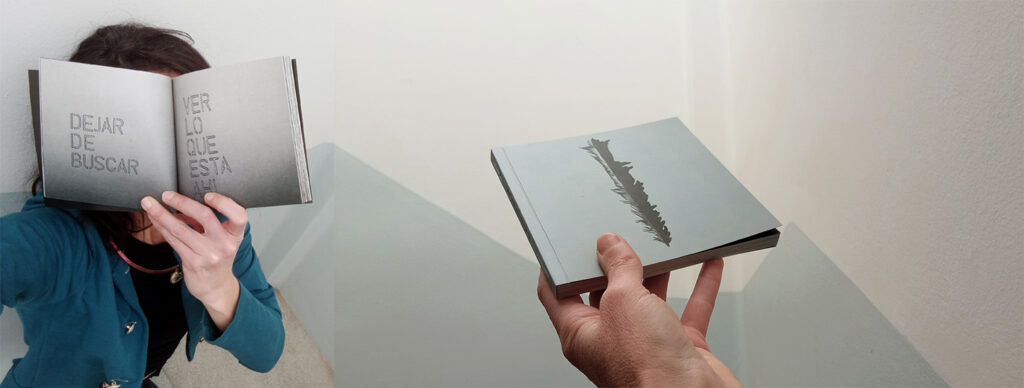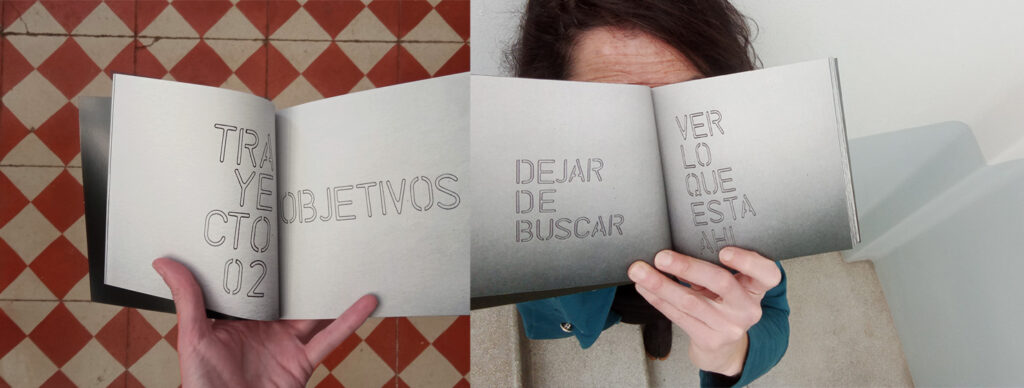ENGLISH BELOW
Que el agua vuelva a fluir
¿Cómo podemos reorientar la mirada hacia aquello que verdaderamente importa cuando estamos asaltados continuamente por todo tipo de urgencias?
Marina Garcés
Se detuvo el tiempo, ralentizamos y ocurrió… No hubo prisas, ni interrogantes o dudas, Ana Matey cambió el yo por el nosotros para unir los elementos que compusieron su proyecto en un gesto sutil y poético. Fue un instante extendido, congelado. La performance final del proyecto ‘El Recolector de Plumas’ en el lecho del río Gallinera fue una sorpresa inesperada. El arte no se entiende, se siente y ese fue un ejemplo. Fue precisamente ahí cuando todo su recorrido cobró sentido mientras el hielo se deshacía y los rayos del sol lo tocaban reflejados en un espejo en movimiento. Ese paisaje surrealista construido con la composición en el lecho de un río seco supuso el cierre del proceso, precisamente en el momento en el que el agua volvió a fluir.
En un proyecto en el que el tiempo es el hilo conductor, la razón y el condicionante, empezar por el final es un ‘coup de theatre’ al que no me he podido resistir. Alterarlo para que pierda su sentido lineal o evidenciar su presencia a través del desorden me permite un juego al que la artista dedicó las dos semanas de la residencia.
Afrontar un proyecto para ella es un enfrentamiento amistoso entre el cuerpo y el entorno, un baile a dos que sigue el compás de los pasos, de la medida, de la escucha del silencio y la lectura de los estímulos. En esta acción repetitiva de caminar, cada paso sirve de mantra sensorial que habilita ese filtro entre lo que encuentra y su interpretación. El acercamiento activo contrasta sus acciones con épocas en las que la inmovilidad, la observación y la pasividad expectante daban el protagonismo a los espectadores y confrontaba con el caos de las metrópolis de las que escapó.
“El Recolector de Plumas” es el título de una serie de trabajos en los que las plumas simbolizan la libertad, con todas las connotaciones que evoca el hecho de recogerlas una vez perdidas. Son una invitación a observar lo que tenemos alrededor, a dar valor al recorrido y a encontrar lo que no se busca. Según afirma Ana, un enigma sobre nuestra forma de vivir, individual y colectivamente.
En esta estación de “El Recolector de Plumas” de la Vall de Gallinera, la ligereza de las plumas se transformó en una solidez aparente, penetrable a través de los orificios del terreno rocoso de la solana. Un contraste entre lo físico y la inmaterialidad de una luz del sol a la que tenía que perseguir en su recorrido, que se filtraba por la superficie porosa. Este fue el primer viraje que dirigió su transitar.
El elemento tiempo, su discurrir y la transformación que nos permite tener conciencia de su paso fue, después de estudiar el territorio, lo que la llevó a reinterpretar su discurso para adaptarlo a lo que se encontró, o más bien a la ausencia y el cambio.
Esa ausencia-presencia permitió un diálogo material e inmaterial con el recorrido a cada paso, cada trayecto. Las zancadas son la unidad de medida espacial y temporal del espacio, un compás que conecta directamente con el territorio y mediante su observación, permite decodificarlo. Como la artista afirma, “estar” en un sitio.
Ana ha realizado un proceso de introspección, de implosión creativa en la que se ha ido desvinculando de todo lo superfluo para quedarse con su esencia y la de lo que le rodea. A partir de ahí plantea una serie de inmersiones a la realidad circundante a través de diferentes canales (acciones, fotografías, transformaciones…) que la funden a ella. Conversa mediante esos guiños con los elementos y se involucra incluso físicamente en una transformación mutua, un mimetismo conceptual.
Aristóteles afirma que no existe el tiempo sin movimiento ni cambio y esta premisa ella la traslada como resultado físico de su propuesta. El hielo es un elemento constante en su obra y este es fruto de una tarde de lluvia. Encierra en él las piedras recogidas, que serán luego liberadas con el deshielo, un símbolo de mutación, de cambio, de paso del tiempo o de constante renacimiento. Estos son elementos conceptuales de la instalación final donde el tiempo se materializa y visualiza.
La estructura del proyecto bascula entorno a un esqueleto que parte de individuar lo ignoto, su análisis y tránsito, de la lectura y la recogida para realizar una traslación de los elementos elegidos a nueva ubicación que los muta, en una metamorfosis recíproca con el nuevo lugar en el que se encuentran.
Enfrentarse a lo desconocido con la curiosidad y los sentidos suscitó una serie de cuestiones que fueron las que guiaron su camino, acompañadas del azar de los objetos encontrados: ¿Cuál es la grieta del pensamiento? ¿Cuál es la fisura de la mente? ¿Cuál sería el puente entre ambas?. Los interrogantes se asocian siempre a un cruce de caminos mentales que en ocasiones crean confusión y caos. Esta vez son abiertas, sin respuesta sino en cada uno de los lectores, en ella misma y en la naturaleza en la que discurre.
Miguel Mallol (comisario)
Texto publicado en el libro de artista «El Recolector de Plumas. Volver a Fluir» Editado por Enclave Land Art 2023
Presentación del libro a cargo de Miguel Mallol y Ana Matey en el Museo La Neomudéjar AQUÍ
Let the water flow again
How can we refocus our gaze on what really matters when we are continually assailed by all kinds of urgencies?
Marina Garcés
Time stopped, we slowed down and it happened… There was no rush, no questions or doubts, Ana Matey exchanged the I for the we to unite the elements that made up her project in a subtle and poetic gesture. It was an extended, frozen instant. The final performance of the project ‘El Recolector de Plumas’ in the bed of the river Gallinera was an unexpected surprise. Art is not understood, it is felt, and this was an example. It was precisely there that her entire journey made sense as the ice melted and the sun’s rays touched her reflected in a moving mirror. This surreal landscape constructed with the composition in the bed of a dry river brought the process to a close, precisely at the moment when the water flowed again.
In a project in which time is the guiding thread, the reason and the conditioning factor, starting with the end is a ‘coup de theatre’ that I couldn’t resist. Altering it so that it loses its linear sense or highlighting its presence through disorder allows me to play a game to which the artist dedicated the two weeks of the residency.
For her, tackling a project is a friendly confrontation between the body and the environment, a two-way dance that follows the rhythm of the steps, of the measure, of listening to silence and reading the stimuli. In this repetitive action of walking, each step serves as a sensory mantra that enables this filter between what it encounters and its interpretation. The active approach contrasts her actions with times when immobility, observation and expectant passivity gave the spectators the leading role and confronted the chaos of the metropolises from which she escaped.
«The Feather Collector» is the title of a series of works in which feathers symbolise freedom, with all the connotations evoked by the act of collecting them once they have been lost. They are an invitation to observe what we have around us, to give value to the journey and to find what we are not looking for. According to Ana, an enigma about our way of living, individually and collectively.
In this station of «El Recolector de Plumas» in Vall de Gallinera, the lightness of the feathers was transformed into an apparent solidity, penetrable through the holes in the rocky terrain of the sun. A contrast between the physical and the immateriality of a sunlight that he had to chase along his route, filtering through the porous surface. This was the first turning point that directed his journey.
The element of time, its passing and the transformation that allows us to be aware of its passage was, after studying the territory, what led her to reinterpret her discourse to adapt it to what she found, or rather to absence and change.
This absence-presence allowed a material and immaterial dialogue with the route at each step, each journey. Strides are the unit of spatial and temporal measurement of space, a compass that connects directly with the territory and through its observation, allows it to be decoded. As the artist states, «to be» in a place.
Ana has carried out a process of introspection, of creative implosion in which she has been detaching herself from everything superfluous in order to remain with her essence and that of what surrounds her. From there she proposes a series of immersions into the surrounding reality through different channels (actions, photographs, transformations…) that fuse her to it. She converses through these winks with the elements and even becomes physically involved in a mutual transformation, a conceptual mimicry.
Aristotle affirms that there is no time without movement or change, and she translates this premise as the physical result of her proposal. Ice is a constant element in her work and it is the fruit of an afternoon of rain. She encloses in it the collected stones, which will later be released with the thaw, a symbol of mutation, of change, of the passage of time or of constant rebirth. These are conceptual elements of the final installation where time is materialised and visualised.
The structure of the project revolves around a skeleton that starts from identifying the unknown, its analysis and transit, from reading and collecting to carry out a translation of the chosen elements to a new location that mutates them, in a reciprocal metamorphosis with the new place in which they are found.
Facing the unknown with curiosity and the senses raised a series of questions that guided her path, accompanied by the randomness of the objects found: What is the crack of thought? What is the fissure of the mind? What would be the bridge between the two? The questions are always associated with a crossing of mental paths that sometimes create confusion and chaos. This time they are open, unanswered but in each of the readers, in herself and in the nature in which it runs.
Miguel Mallol (curator)
Text published in the artist’s book «El Recolector de Plumas. Volver a Fluir» Published by Enclave Land Art 2023




Comentarios recientes